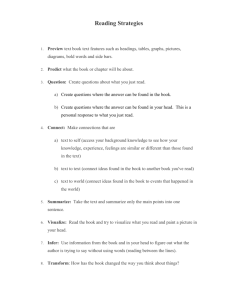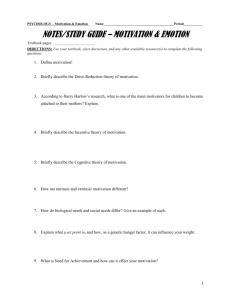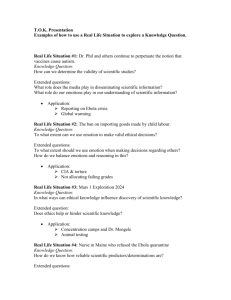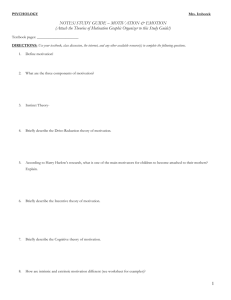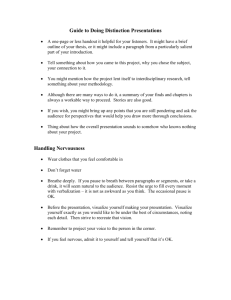The Power of the Image - Laura Terrill
advertisement
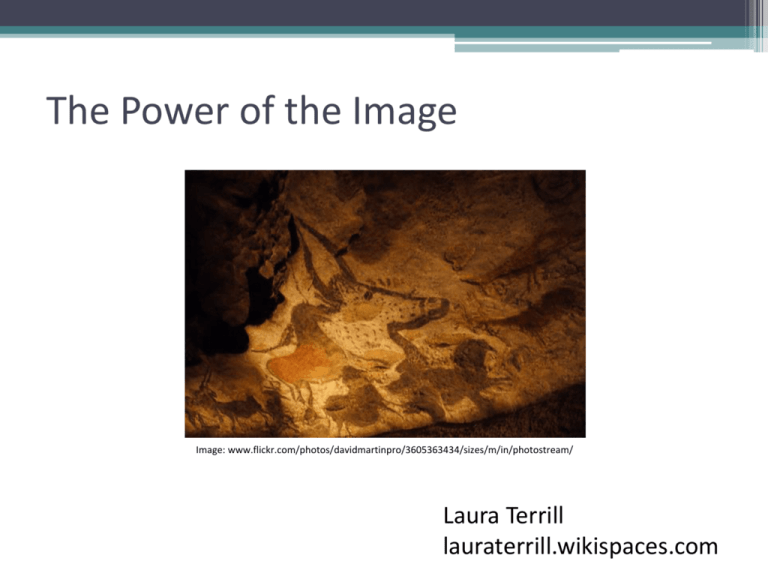
The Power of the Image Image: www.flickr.com/photos/davidmartinpro/3605363434/sizes/m/in/photostream/ Laura Terrill lauraterrill.wikispaces.com Communication What does it mean to be proficient in a language? or How will my students use what I am teaching in a real-life context? or Will they really say it on the streets of (Paris)? head foot hand stomach eyes nose ears mouth knee hair Proficiency? List 10 parts of the body. What’s wrong? Do you have a headache? Conjugate the verb “to be”. You have a new dog! What’s he like? Use the future tense to say what you are going to do. What will you do next weekend? Answer with a direct object pronoun. When did you have time to read that book? Images can be used to…… • Provoke emotion • Stimulate higher order thinking • Introduce/tell cultural stories • Visualize vocabulary in context • Consider cultural perspectives • Address the modes of communication Cognition and Retention It is through the senses that we interact with, and learn about, the world around us (Walker & Chaplin 1997 p.19). In particular, some people remember better what they see rather than what they hear, and if there is emotion involved, the memory is enhanced even more (Swetmon 1998, p.7). If memory is enhanced, knowledge can be retained. Once cognitive processing of knowledge has taken place learning is deemed to have occurred (Morgan & Welton 1992) Considering Visual Literacy When Designing Instruction, Michael D Sankey The Courage to Teach Intellect works in concert with feeling, so if I hope to open my students’ minds, I must open their emotions as well. Parker J. Palmer Complex Thinking — Simple Language No soy un abrigo. Helena Curtain Images can be used to…… • Provoke emotion • Stimulate higher order thinking • Visualize vocabulary in context • Introduce/tell cultural stories • Consider cultural perspectives • Address the modes of communication It’s raining. Let’s go swimming. ? Water on a tropical island ??? Going by boat to an island for the day ??? Visual Thinking Strategies Students learn by: • Looking carefully at works of art • Talking about what they observe • Backing up their ideas with evidence • Listening to and considering the views of others • Discussing many possible interpretations Visual Understanding in Education visualthinkingstrategies.org vue.org Visual Thinking Strategies Three key questions: 1. What is going on in this picture? 2. What do you see that makes you say that? 3. What more can we find? Visual Understanding in Education visualthinkingstrategies.org vue.org Qu’est-ce que c’est? Images can be used to…… • Provoke emotion • Stimulate higher order thinking • Visualize vocabulary in context • Consider cultural perspectives • Introduce/tell cultural stories • Address the modes of communication Images can be used to…… • Provoke emotion • Stimulate higher order thinking • Visualize vocabulary in context • Consider cultural perspectives • Introduce/tell cultural stories • Address the modes of communication Los Reyes debían hacer felices a otros niños con regalos que dejarían en sus casas…… También hallaron en el libro la forma de viajar rápido…… Se preguntaban cómo iban a repartir los regalos, cuando de pronto apareció…. Pero algo terrible sucedió…. A partir de entonces, los Reyes Visitan las casas puertorriqueñas. Images can be used to…… • Provoke emotion • Stimulate higher order thinking • Visualize vocabulary in context • Consider cultural perspectives • Introduce/tell cultural stories • Address the modes of communication Three Modes of Communication Interpretive Presentational Interpersonal Speaking Test Sports et Loisirs Role-play B: You are being interviewed for a position as a camp counselor. Have a conversation in which you: • ask questions to find out what you would do each day • explain what you really like to do • justify why you don’t like to do something Ask Questions Image: http://1jour1actu.com/monde/une-journee-mondiale-contre-le-travail-des-enfants/ Yesterday – Today - Tomorrow What did you do? What are you going to do? What are you doing? Laura Terrill World Language / ELL Consultant 8529 Stark Drive Indianapolis, IN 46216 Cell: 314-369-9678 Home: 317-546-2626 Email: lterrill@gmail.com lauraterrill.wikispaces.com

